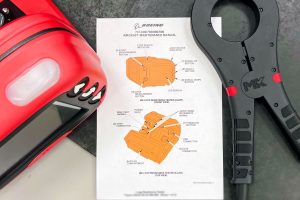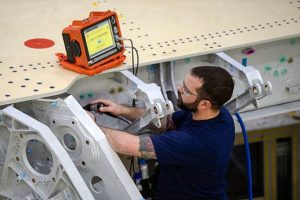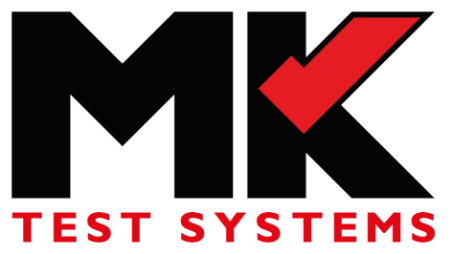How to choose a loop resistance tester

Modern loop resistance tester tools have several features designed to make prescribed testing easier and faster than ever before. This article is a quick guide on the top features to look for when you’re sourcing an LRT.
OEM approval

Is the tool specified for use by the aircraft manufacturer? It goes without saying that to comply with FAA ACO Airworthiness Directives, you need to be using approved equipment.
Before purchasing any new tools, check the latest AMM or TEM for updates regarding the current approved kit list. Also carry out due diligence to ensure any claims of approval can be substantiated with letters or other documentation. “Equivalency” must also be proven.
Price of the loop resistance tester
The adage “you get what you pay for” is totally true here, and a mid-to-high price range is about where you want to be.
A tool which is priced low can mean you’ll be missing some key useful features. At the other end of the market is the legacy tester, which was priced on the fact that it was originally the only Boeing-approved tool. The market has changed, and the price point of the legacy kit doesn’t reflect the wider options available.
Battery life
Battery power is the pulse of modern life, as everything from fishing rods to water bottles now come with a battery and therefore need charging.
Within aviation and other industries, dead batteries cost businesses money due to wasted testing downtime. Add the fact that accuracy of readings may be reduced when the batteries are running out and it’s not just an annoyance but potentially a missed fault.
To eliminate the dreaded blank screen, look for equipment which has hot swap batteries; these enable testing to continue even whilst the batteries are being replaced.
Calibration options
All equipment needs to be calibrated to ensure accuracy, but it’s still a frustrating reason for kit to be out of action.
Check what the calibration process is for the tool – can it be calibrated onsite by a member of your staff or does it need to be returned to the manufacturer? How long does calibration take? If returned to manufacturer, do they charge for this? The difference in calibration downtime between manufacturers can be over 2 months; that’s a long time for your equipment to be out of service.
Reliability of readings

It sounds obvious but you need to ensure that the tool you’re using is giving you accurate results. One reassurance is to use the products recommended by the OEM – they only recommend a specific tool because they independently test and verify its efficacy.
Safety classification of the loop resistance tester
The criteria for safe use of tools is dependent on your working environment. If you’re working on fuelled aircraft you need to be using an intrinsically safe tool, whereas purged aircraft, OEM parts or FAL can follow a less stringent set of requirements. The different area classifications according to ATEX regulations are:
- Zone 0: An area in which an explosive gas atmosphere is present continuously or for long periods of time.
- Zone 1: An area in which an explosive gas atmosphere is likely to occur under normal operating conditions.
- Zone 2: An area in which an explosive gas atmosphere is not likely to occur under normal operating conditions.
- Non-hazardous: An area with very low risk of release of explosive or flammable gas; such as the propellant in an aerosol spray in an office.
Up to date technology
Look out for modernised tools that simplify the testing process, enabling you to improve productivity and make your operational staff happy. The following features support operator usage and reporting and are the key to successfully integrating a new tool into your facility:
- Automatic programming
- WiFi / USB / Bluetooth capabilities
- Pass/fail status indication
- Integrated user guidance
Delivery leadtime
The business need has been identified and agreed, the technical spec is approved, and the PO for your new tool has been raised – so now you wait. And wait. A long lead time can more than double the critical path so it’s worth considering whether the project can justify this delay.
Look for a supplier who has product available from stock or who can offer an acceptable lead time.
Use the right tool for the job
Ensure the tool you use is designed for the test you need to perform.
A bond meter is not accurate enough for loop and joint tests. Why? The bond meter cannot detect open circuits in complex parallel networks, so using one inappropriately can result in bad joints passing inspection.
To reiterate, you should not be using a bond meter to carry out loop and joint resistance tests.
Fit for purpose
Is the tool truly portable? A tool that weighs 20kg or is too large to fit through aircraft portholes is not the ideal tool for use in either manufacturing or MRO environments.
Is the tool fragile or built for the laboratory environment, or is it built for the hanger and shop floor? A fragile and heavy tool will inevitably mean downtime through damage or needing for 2 operators to carry out a task.
Selecting a tool that is built to withstand the rigors of the flightline and MRO environment is vital for the efficiency of your business.
Next steps
Want to share or save this guide? Get the free PDF download here.
For more information on our range of loop resistance tools vs the legacy LRT, read our comparison article.
